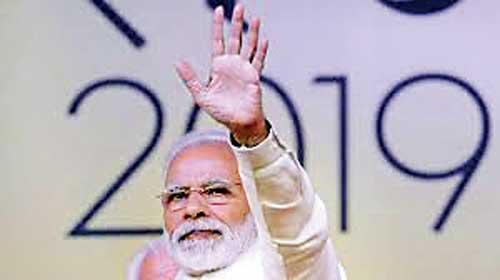21 May 2019 - {{hitsCtrl.values.hits}}
(Mumbai/Bengaluru) REUTERS: Indian stocks saw their biggest single-day gain since September 2013 yesterday while the rupee and bonds rallied after exit polls showed Prime Minister Narendra Modi was set to win a second term with an even bigger mandate than in 2014.
Modi’s National Democratic Alliance (NDA) was projected to win between 339 and 365 seats in the 545-member lower house of parliament when votes are counted on Thursday following the mammoth seven-phase election that ended on Sunday.

Markets had been expecting the NDA to win a second term but the margin of victory as suggested by the polls is a clear surprise and expected to keep sentiment buoyant in the near term.
The NDA is seen to be relatively more fiscally disciplined and less populist in nature, which should augur well for inflationary dynamics, Madhavi Arora, economist, FX and rates at Edelweiss Securities wrote in a note.
“Some pick-up in fresh private investment may happen with policy and political certainty. But overall, policy focus should be on structural measures rather than mere policy rate cuts or looser fiscal stance,” Arora said.
The NSE share index closed up 3.69 percent at 11,828.25 points while the benchmark BSE index ended 3.75 percent higher at 39,352.67 points. This is the biggest single-day gain for both indices since September 10, 2013.
Fund managers expect markets to see another 3-4 percent rally in markets over the next few days depending on global cues but a further sharp upside is unlikely if results are in line with predictions, they said.
Markets are likely to hold in a range ahead of the vote count on Thursday with a bullish bias. The Nifty has broken the strong resistance it had seen at 11,800 levels and could now look to move towards 12,200, analysts said.
“What would help the markets sustain the momentum is factors that are fundamentally important, like decisive policy initiatives from the new government, faster land and labour reforms and also the unfinished task of quick consolidation and reorganisation of the banking system,” said Emkay Wealth Management Head of Research Joseph Thomas.
India’s bonds and rupee have both held in a tight range in recent weeks despite the positive underlying bias as investors stayed on the sidelines awaiting the election outcome.
Low inflation and foreign fund inflows have aided the rupee while the central bank’s efforts to ensure adequate liquidity in the banking system through forex swaps and open market bond purchases have helped bonds.
“In terms of policies, we hope to see a continuation of what we saw in the first part of Modi’s first term when the government implemented measures to improve the business climate, the bankruptcy code, GST, demonetisation,” said ABN AMRO Amsterdam Chief Asia Economist Arjen van Dijkhuizen.
“The later part of his term has been more populist to appease his voter base. We now hope the momentum on reforms will accelerate,” he added.
The partially convertible rupee was trading at 69.73/74 per dollar at 1107 GMT, after rising to 69.3550 in opening deals at which point it was up 1.2 percent on the day.
Investors expect the rupee to hold in a 69-72 per dollar range in the medium term with global oil prices having the potential to push it lower.
The rupee had closed Friday at 70.22. Further gains in the rupee will also depend on flows into the stock markets.
The benchmark 10-year bond yield was trading at 7.29 percent, down 7 basis points on the day after briefly falling to a low of 7.27 percent.
Though investors are happy with the idea of continuity, they felt that a lot of the work that has been done by the government to generate economic growth has not yet been felt. They said the second five-year term would give Modi the opportunity to implement those reforms and deliver on growth.
“I would expect more over the next five years,” said Ocean Dial Asset Management Chief Investment Officer David Cornell.
“A lot has been done but a lot more needs to happen in terms of the judiciary, generating employment growth, public sector divestment, attracting foreign investment, improving the fiscal deficit. So there is an awful lot more that needs to be done.”
15 Nov 2024 13 minute ago
15 Nov 2024 19 minute ago
15 Nov 2024 31 minute ago
15 Nov 2024 55 minute ago
15 Nov 2024 1 hours ago